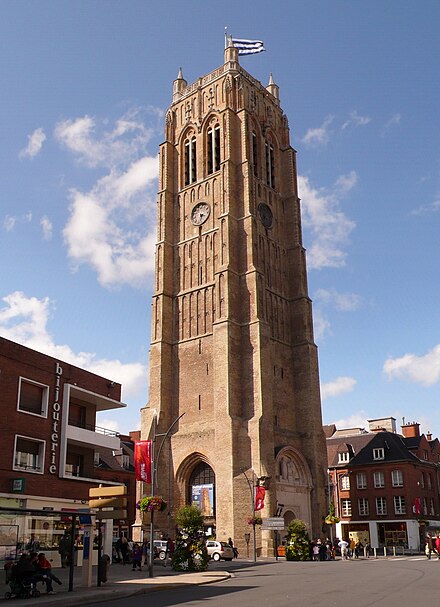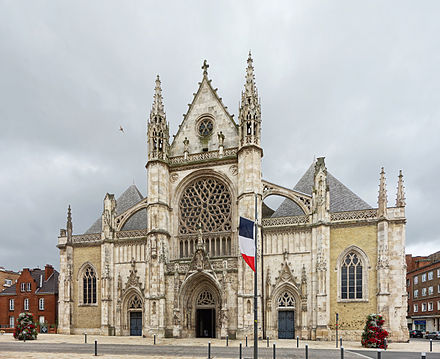Dunkirk - commune in Nord, France
Dunkirk (French: Dunkerque, Dutch: Duinkerke) is a town in the region of Hauts-de-France in France. The town is a historic resort, 10 km from the border with Belgium. If you're coming from the UK, it's a great place to start your journey further into the Continent, but also a great holiday destination on its own, featuring historic beaches, shopping locations, and many places to eat local food, which is an interesting fusion of traditional Flemish cooking and seafood. It is famous as the site of the Dunkirk Evacuation during World War II, when, over eight days, a fleet of British, Canadian and French Navy and a huge assortment of civilian vessels — 900 boats in all — evacuated 338,000 British and French soldiers who had been encircled on land by German armies.


Understand
The name Dunkirk comes from the Dutch language "Church of the Dunes".
Dunkirk has the third-largest harbour in France, after those of Le Havre and Marseille. As an industrial city, it depends heavily on the steel, food processing, oil-refining, ship-building and chemical industries.
History
A fishing village arose late in the 10th century. About AD 960, Count Baldwin III had a town wall erected in order to protect the settlement against Viking raids. The surrounding wetlands were drained and cultivated by the monks of nearby Bergues Abbey.
In the 14th century, trade flourished and the port and fortifications were significantly enlarged. In 1482, Dunkirk, along with the rest of Flanders, was incorporated into the Netherlands.
The area remained much disputed between Spain, the Netherlands, England and France. It was ruled by each of these countries through the early 17th century, becoming a part of France in 1662. The French government developed the town as a fortified port. The town's existing defences were adapted to create ten bastions. The port was expanded in the 1670s by the construction of a basin that could hold up to thirty warships with a double lock system to maintain water levels at low tide. The basin was linked to the sea by a channel dug through coastal sandbanks secured by two jetties.
In World War I, the city experienced severe bombardment. On a regular basis, heavy shells weighing approximately 750 kg were fired from Koekelare, about 45–50 km away.
In World War II, the Allied expeditionary force was surrounded in Dunkirk in 1940. 338,000 soldiers were evacuated from Dunkirk to England in Operation Dynamo. The operation has been depicted in several motion pictures, including Christopher Nolan's 2017 film Dunkirk. The withdrawal, which was militarily a defeat, was seen as a miraculous saving of soldiers whom the British public had thought lost to capture or killing and gave a much needed morale boost. British politicians still like to invoke the "Dunkirk spirit" in times of national crisis.
Get in
By boat
Up to 12 DFDS Seaways car ferries per day cross the sea from Dover (England). The ferry service does not accept passengers on foot, but does accept cyclists. The port of Calais, which receives even more regular crossings from Dover and does take foot passengers, is about 50 km by road or rail from Dunkirk.
By train
SNCF high-speed trains (TGV) serve Dunkirk from Lille (Europe), Lens, Arras and Paris (Nord). Local trains operated by TER Hauts-de-France come in from nearby towns such as Calais (Ville).
By road
Dunkirk is served by two motorways. The A16 comes up from Amiens, Boulogne, the Channel Tunnel and Calais, passing Dunkirk and continuing across the Belgian border as the E40 towards Ostend, Bruges, Ghent and Brussels. The A25 comes from Lille, where it connects with the A1 from Arras and Paris
By plane
The closest airport receiving scheduled flights is Ostend-Bruges International Airport 📍 (IATA: OST), which primarily caters for locals travelling to resorts in southern Europe. It is around 60 km to the east near Ostend, Belgium. Due to the Schengen Agreement there is no passport control when crossing from Belgium to France.
For more information on nearby airports, consult the Hauts-de-France and Flanders articles.
Get around
The public buses are free of charge since September 2018.
See
- Port Museum (Musée Portuaire), 9 Quai de la Citadelle, 51.0379°, 2.37168°, +33 3 28 63 33 39. Daily 10:00-12:30, 13:30-18:00. The Port Museum is housed in a former 19th-century tobacco warehouse. The museum provides insights into the nautical world of a large port from historical and contemporary perspectives. €6 2016-04-18

- Saint-Éloi church, 2 Rue Clemenceau, 51.035556°, 2.376944°, +33 3 28 29 07 74. . 2018-02-03
- Town Hall.
- Allies Memorial.
- Memorial and Town Cemetery.
- Malo-les-Bains beach front.
- Operation Dynamo 1940 Museum (Musée Dunkerque 1940 – Opération Dynamo), Rue des Chantiers de France, 51.046143°, 2.381201°, +33 9 75 86 23 03. Daily 10:00-18:00. 2018-02-03
- LAAC Museum of Contemporary Art (LAAC, Lieu D'art et Action Contemporaine), Avenue des Bordées, 51.0461°, 2.38253°, +33 3 28 29 56 00, art.contemporain@ville-dunkerque.fr. Daily 10:00-12:15, 14:00-18:00. This museum is at the heart of a sculpture garden. It presents an exhibition of art from 1950s to today. €3 2016-04-18
- Museum of Fine Arts (Musée des Beaux-Arts), Place du Général de Gaulle, 51.036°, 2.38136°. This museum present a collection of Flemish, Dutch, French, and Italian paintings from the 16th to 19th centuries. The collections also include a collection which includes over 10,000 natural history specimens, numerous decorative crafts and archeological finds. 2016-04-18
Do
- "Une Digue": take a walk on the Malo-les-Bains dike, between beach and "turn of the century" villas while eating an ice cream.
- On Saturday evening, take a stroll on the seawall: the atmosphere is in the bars.
Carnival
 Carnival an institution in Dunkirk and throughout its region. The heart of the carnival is around Ash Wednesday, which occurs in February or March, seven weeks before Easter. Before this, there are les Trois Joyeuses (the Three Joyfuls): Sunday in Dunkirk, Monday in the citadel and Tuesday in Rosendaël. The next Sunday, it's Malo.
Carnival an institution in Dunkirk and throughout its region. The heart of the carnival is around Ash Wednesday, which occurs in February or March, seven weeks before Easter. Before this, there are les Trois Joyeuses (the Three Joyfuls): Sunday in Dunkirk, Monday in the citadel and Tuesday in Rosendaël. The next Sunday, it's Malo.
For 2½ months, there is a happy, family-friendly atmosphere. Every Saturday night there is a grand ball. Bands and orchestras play in the streets every Sunday afternoon. On Shrove Tuesday, there are huge colourful parades. A 60-member orchestra dressed as fishermen leads revellers and big wicker mannequins in front of the City Hall, and people gather in the square to receive herrings: almost 450 kg of wrapped, smoked herrings are thrown down from the balcony for the occasion.
Buy
Eat
The cuisine of Dunkirk closely resembles Flemish cuisine; perhaps one of the best known dishes is coq à la bière – chicken in a creamy beer sauce. Another typical dish is the Potjevleesch, a dish of white meat (veal, pork, rabbit, chicken) cooked and preserved in jelly flavoured with juniper berries.
Budget
All these are in the city centre:
- Fresh Burritos Dunkerque, 14 ter Rue de l'Amiral Ronarc'h, 51.0355542°, 2.3743947°. 2022-08-01
- BCHEF, 1 Bd Alexandre III, 51.0341293°, 2.3770273°. Build your own sandwich 2022-08-01
- La Mie Câline, 28 Bd Alexandre III, 51.0338158°, 2.3762927°. 2022-08-01
- Le Wilson, 54 Rue du Président Wilson, 51.0339259°, 2.3747320°. 2022-08-01
- Les Coulisses, 43 Rue des Sœurs Blanches, 51.0368961°, 2.3802396°. 2022-08-01
- Friterie du Mynck, 38 Pl. du Minck, 51.0393876°, 2.3785384°. 2022-08-01
- Le Mc Arthur, 8 Rue Belle Vue, 51.0326359°, 2.3687818°. 2022-08-01
Mid-range
- Le P'tit Dunkerque, 32 Pl. Charles Valentin, 51.0379283°, 2.3776435°. French cuisine 2022-08-01
- L'escargot, 8 Rue de la Maurienne, 51.0361015°, 2.3759933°. 2022-08-01
- Mary Jane, 13 Bis Quai de la Citadelle, 51.038737°, 2.3731364°. 2022-08-01
- Le Puzzle, 6 Quai de la Citadelle, 51.0373974°, 2.3715589°. French 2022-08-01
- L'inattendu, 22 Pl. Jean Bart, 51.0343593°, 2.3781350°. 2022-08-01
Splurge
- Le Soubise, 49 Rte de Bergues, 51.0050039°, 2.3822294°. 2022-08-01
Drink
Sleep
Connect
Go next
Dunkirk
ville-dunkerque.frNorth
2nd-order administrative division
Hauts-de-France
Primary administrative division